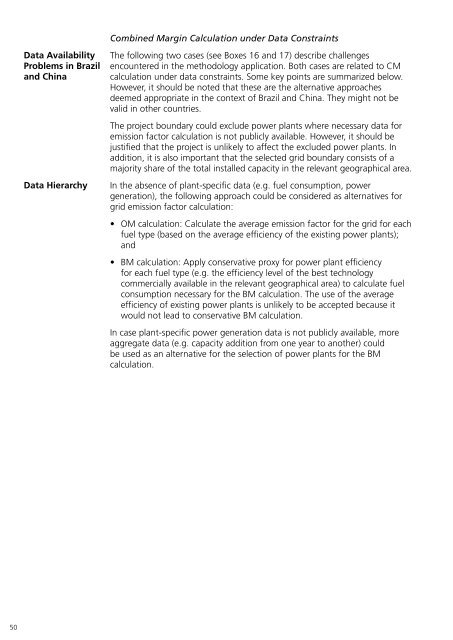Understanding CDM Methodologies - SuSanA
Understanding CDM Methodologies - SuSanA
Understanding CDM Methodologies - SuSanA
Create successful ePaper yourself
Turn your PDF publications into a flip-book with our unique Google optimized e-Paper software.
Data Availability<br />
Problems in Brazil<br />
and China<br />
Combined Margin Calculation under Data Constraints<br />
The following two cases (see Boxes 16 and 17) describe challenges<br />
encountered in the methodology application. Both cases are related to CM<br />
calculation under data constraints. Some key points are summarized below.<br />
However, it should be noted that these are the alternative approaches<br />
deemed appropriate in the context of Brazil and China. They might not be<br />
valid in other countries.<br />
The project boundary could exclude power plants where necessary data for<br />
emission factor calculation is not publicly available. However, it should be<br />
justified that the project is unlikely to affect the excluded power plants. In<br />
addition, it is also important that the selected grid boundary consists of a<br />
majority share of the total installed capacity in the relevant geographical area.<br />
Data Hierarchy In the absence of plant-specific data (e.g. fuel consumption, power<br />
generation), the following approach could be considered as alternatives for<br />
grid emission factor calculation:<br />
• OM calculation: Calculate the average emission factor for the grid for each<br />
fuel type (based on the average efficiency of the existing power plants);<br />
and<br />
• BM calculation: Apply conservative proxy for power plant efficiency<br />
for each fuel type (e.g. the efficiency level of the best technology<br />
commercially available in the relevant geographical area) to calculate fuel<br />
consumption necessary for the BM calculation. The use of the average<br />
efficiency of existing power plants is unlikely to be accepted because it<br />
would not lead to conservative BM calculation.<br />
In case plant-specific power generation data is not publicly available, more<br />
aggregate data (e.g. capacity addition from one year to another) could<br />
be used as an alternative for the selection of power plants for the BM<br />
calculation.<br />
50

















